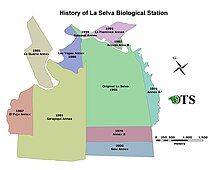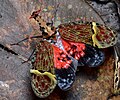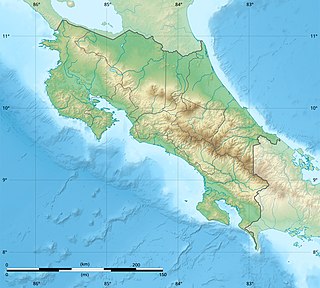
Costa Rica is located on the Central American Isthmus, surrounding the point 10° north of the equator and 84° west of the prime meridian. It has 212 km of Caribbean Sea coastline and 1,016 on the North Pacific Ocean.

Heredia is a province of Costa Rica. It is in the north-central part of the country. As a result, the province covers areas as diverse as the agriculture-rich Northern plains to the more metropolitan areas such as the city of Heredia in the Central Valley. It contains several major environmentally important areas such as the Braulio Carrillo National Park and the Sarapiqui River. The capital is the city of Heredia.
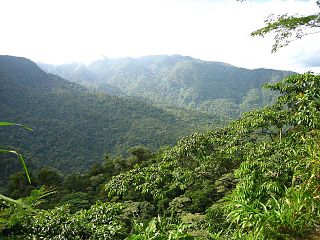
Braulio Carrillo National Park is a national park in Heredia Province, Cartago Province, Limón Province and San José Province, in central Costa Rica. It is part of the Central Conservation Area.
Maquenque Wildlife Refuge, is a protected area in Costa Rica, managed under the Arenal Huetar Norte Conservation Area, it was created in 2005 by decree 32405-MINAE.

The great green macaw, also known as Buffon's macaw or the great military macaw, is a critically endangered Central and South America parrot found in Nicaragua, Honduras, Costa Rica, Panama, Colombia and Ecuador. Two allopatric subspecies are recognized; the nominate subspecies, Ara ambiguus ssp. ambiguus, occurs from Honduras to Colombia, while Ara ambiguus ssp. guayaquilensis appears to be endemic to remnants of dry forests on the southern Pacific coast of Ecuador. The nominate subspecies lives in the canopy of wet tropical forests and in Costa Rica is usually associated with the almendro tree, Dipteryx oleifera.
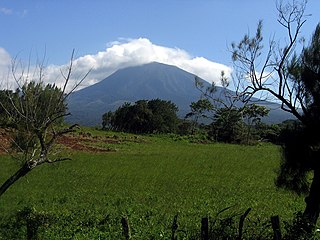
Guanacaste Conservation Area is an administrative area which is managed by the Sistema Nacional de Areas de Conservacion (SINAC) of Costa Rica for conservation in the northwestern part of Costa Rica. It contains three national parks, as well as wildlife refuges and other nature reserves. The area contains the Area de Conservación Guanacaste World Heritage Site, which comprises four areas.
Alberto Manuel Brenes Biological Reserve is a nature reserve in the central part of Costa Rica. It is part of the Central Conservation Area; which protects tropical forest area near San Ramon. The reserve operates under the direction of the University of Costa Rica and the Ministry of Environment and Energy (MINAE).
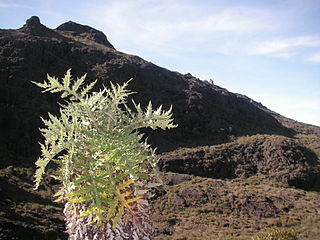
Chirripó National Park is a national park of Costa Rica, encompassing parts of three provinces: San José, Limón and Cartago. It was established in 1975.
Piedras Blancas National Park is a national park part of the Osa Conservation Area. It is found in the Puntarenas Province of southern Costa Rica near the town of La Gamba. It protects rainforests and beaches near the Golfo Dulce on the Pacific Coast. It used to operate as part of the Corcovado National Park called the Esquinas Sector from 1991 before becoming a separate park in 1999. Until the mid-1990s, much of the forest in the park was severely endangered by logging.
Puerto Viejo is a district of the Sarapiquí canton, in the Heredia province of Costa Rica.
Indio Maíz Biological Reserve is situated on the southeastern corner of Nicaragua bordering the San Juan River and Costa Rica. Measuring about 3,180 square kilometers, it is one of the largest protected lowland forest system in Central America, the second largest lowland rainforest reserve in Nicaragua and is a key component in the proposed Mesoamerican Biological Corridor. It has previously been referred to as "the gem of Central American nature reserves" by UCLA biologists. Indio Maíz is rich in biodiversity, holding a higher number in species of trees, birds, and insects than all of Europe. In recent years, a growing timber and oil palm industry has led to increasing rates of deforestation along the northern and western flanks of Indio Maíz.
The Organization for Tropical Studies (OTS)/Organización para Estudios Tropicales (OET), founded in 1963, is a non-profit consortium of over 50 universities and research institutions based in the United States, Latin America, and South Africa. OTS manages a network of ecological research stations in Costa Rica and South Africa. The North American Office is located on the Duke University campus in Durham, North Carolina. OTS offers a variety of courses in Spanish and English for high school, university, graduate students and professionals. Most of the coursework and research conducted at OTS stations focuses on tropical ecology, and the three research stations in Costa Rica are located in distinct ecoregions. OTS provides housing and a cafeteria for students researchers, and sometime ecotourists. OTS is involved in the policy related to tropical biology through courses, hosting meetings and conferences and managing conservation related projects
The Palo Verde Biological Research Station is located in the Guanacaste Province of Costa Rica, and is one of the three research stations operated by the Organization for Tropical Studies (OTS). The Biological Research Station is located inside Palo Verde National Park. Palo Verde Biological Research Station is one of the foremost sites for ecological research on tropical dry forests, which constitute one of the most endangered forest types in the world.

The Monteverde Cloud Forest Reserve is a Costa Rican reserve located along the Cordillera de Tilarán within the Puntarenas and Alajuela provinces. Named after the nearby town of Monteverde and founded in 1972, the Reserve consists of over 10,500 hectares of cloud forest. It draws roughly 70,000 visitors a year. The reserve consists of 6 ecological zones, 90% of which are virgin forest. A high biodiversity area, consisting of over 2,500 plant species, 100 species of mammals, 400 bird species, 120 reptilian and amphibian species, and thousands of insects, has drawn both scientists and tourists alike.

Tortuguero National Park is a national park in the Limón Province of Costa Rica. It is situated within the Tortuguero Conservation Area of the northeastern part of the country. Despite its remote location, reachable only by airplane or boat, it is the third-most visited park in Costa Rica. The park has a large variety of biological diversity due to the existence within the reserve of eleven different habitats, including rainforest, mangrove forests, swamps, beaches, and lagoons. Located in a tropical climate, it is very humid, and receives up to 250 inches (6,400 mm) of rain a year.
Imara analibiae is a moth in the Castniidae family. It is found in the forest of the Estación Biológica La Selva, near Puerto Viejo, Sarapiquí, Heredia Province in Costa Rica. The habitat consists of a mosaic of mature lowland forest, secondary growth forest of various ages and abandoned pastures.

The Mache-Chindul Ecological Reserve is an ecological reserve in the provinces of Esmeraldas and Manabí, Ecuador. It protects a mountainous area in the transition from tropical rain forest in the north to dry forest in the south. It contains the Cube Lagoon, which has been designated a Ramsar wetland of international importance.
Deborah A. Clark is a Research and adjunct professor of Tropical Ecology at the University of Missouri-St. Louis. For over 40 years she has worked with her partner David B. Clark on the zoology, botany, geosciences, ecology, and climatology of the rain forests in Costa Rica.
The Indigenous Territory of Kéköldi is one of the Costa Rican indigenous communities and one of the four of the Bribri people. It was created in 1977 and has about 210 inhabitants. It is located in the Talamanca-Caribe biological corridor that covers about 36,000 hectares in the canton of Talamanca, Limón Province. Since 1994, the reserve is run by the Kéköldi Wak ka Köneke Association, which works to preserve indigenous culture and purchase additional land to reforest and conserve. The majority of the population speaks both Bribri and Spanish. The reserve has a biological station for scientific research and a bird watching area for tourists.
Catherine Mann Pringle is a distinguished research professor at the Odum School of Ecology at the University of Georgia. She studies aquatic ecosystems and conservation. Pringle has previously served as president of the Society for Freshwater Science. She is a Fellow of the American Association for the Advancement of Science and the Ecological Society of America.

